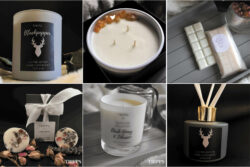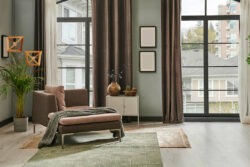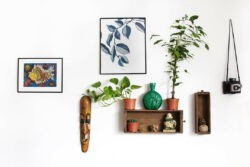By Katherine Sorrell
Combine practicality with good looks to create a welcoming entrance to your home.
As you step into your front hall, does it make you feel calm, happy and welcomed? Or does clutter or a dated decor create stress and frustration? If you’re unhappy with your hall, there are five key areas to consider, from basic function to beautiful decoration.
1 Walls
Halls are both the greeting to your home and a passing-through place in which people generally don’t linger, which means they’re a great area in which to make an instant, bold impression. With a coat or two of paint you can transform a bland hallway into a colourful and stylish area that shows off your unique style, or if you have a larger budget and a bit more time you could opt for wallpaper, tiles or timber cladding. Choose a colour or design that you love, and that coordinates with the colours in adjoining rooms. While pale colours reflect light and emphasise a sense of space, dark schemes can be both cosy and interesting, and will be fine provided you have adequate lighting. For practicality, especially in busy homes with children and/or dogs, consider protecting at least the lower halves of the walls from wear and tear with tiles, timber or extra-tough paint. Period-style patterned tiles, beaded wall panelling or embossed wallpapers are particularly appropriate for older properties with original features, while in a modern home you could go for geometrics, oversized florals or tongue-and-groove cladding.
2 Flooring
Adding a runner will instantly revive a tired or boring hall floor. Consider a washable example, either in cotton or made from recycled plastic, or a dark colour that won’t show the dirt. Not such a quick fix, but hopefully not too tricky either, would be to sand and varnish an old timber floor, or replace tired carpet or vinyl with a fresh new look. In the long run, as budget allows, you may want to consider changing the floorcovering entirely. What to choose? Hall floors need to be the toughest of all – not only durable but also non-slip, resistant to dirt and stains, and easy to clean. Tiles are a great choice: hard-wearing and quick to mop clean. Options include stone, ceramic or quarry, or colourful Victorian-style encaustic (perfect for period properties). Timber boards or parquet will need regular polishing or waxing, though some brands have introduced water-resistant, extra-tough boards that are super-easy to care for. Be careful with some laminates – although cheaper, they may not last long in such a well-used space. Good quality vinyl flooring, in sheet or tile form, is sturdy and cleanable, and comfortable underfoot. For a more luxurious feel, a dark wool carpet in an 80:20 mix of wool and nylon with a twist pile should withstand heavy usage or, for a more rustic look, there’s the option of tough natural matting such as coir, sisal or rush.
3 Lighting
Halls are often windowless and correspondingly dark and, while they do not need to be bright enough for reading, they should be welcoming and lead the eye into your home, as well as safely illuminating any steps or thresholds. It may help to use a specialist light-reflecting paint, or wallpaper with a metallic sheen. Add a large mirror, too – great for checking your reflection just before you leave the house. In terms of light fittings, wall lights are not ideal in a narrow hall, as they may just act as obstacles unless fitted high up. A series of recessed ceiling downlights will do the trick or, if your ceilings are tall enough, a pendant (or a row of them) – in glass, metal, timber or other material – would be ideal.
4 Storage
Most people store all sorts of everyday items in their halls, from coats and scarves to buggies or vacuum cleaners, and ideally it will be tucked away as neatly as possible to avoid being greeted by mess every day. Built-in storage makes the most of every inch of space – wall-to-wall and floor-to-ceiling, including any wonky areas, recesses and changes in level (under-stairs storage can be incredibly useful if designed to optimise the space). Tall, shallow cupboards with doors painted the same colour as the walls, or mirrored to reflect light, will hold an enormous amount yet be barely noticeable. On the other hand, you could make a statement with a choice of freestanding, perhaps vintage or upcycled, cupboards, sideboards or console tables. Umbrella stands, dog beds and boot racks are ideal for spacious, country-style halls, while narrow, urban halls might benefit from a high-up hook for a bike, a slender coat rack and a slim shelf above a radiator on which to keep post and keys.
5 Decoration
Paintings or photographs can really make an impact in a hallway and up the stairs; think about how their colours and designs work with the scheme as a whole. If there is enough light, some house plants in attractive pots are always a fabulous addition, as are a few books sitting on a side table or a shelf. If you have a console table or a deep shelf, add a lamp, a pretty basket for keys and other odds and ends, and a vase of flowers for instant colour and scent the moment you step through the door.







